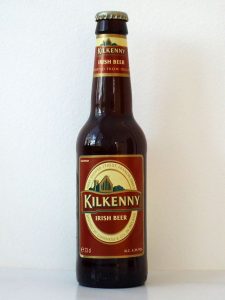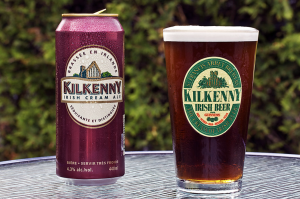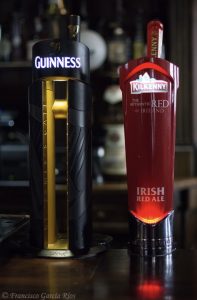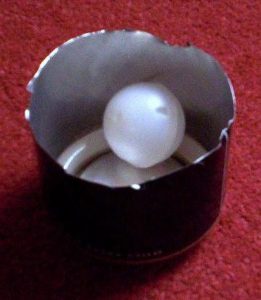28 Kilkenny
jenniferrammler
Introduction

Sláinte! Welcome to Kilkenny – beer that comes from the oldest brewing history in Ireland (Just Beer, n.d). Kilkenny is a classic Irish Ale that has a fresh malty nose with an entertainingly creamy but slightly bitter, coffee, raisin, and plum palate (LCBO, 2021). The Kilkenny recipe comes from the Smithwick’s family brewery and the ale’s name was originally used in the 1980’s and 1990’s for the European and Canadian markets that had a hard time with Smithwick’s pronunciation (DBpedia, n.d). The lovely Kilkenny ale, originally brewed in Kilkenny, Ireland, was made to have an enhanced flavour profile to Smithwick’s (DBpedia, n.d). Kilkenny’s two largest importers are Canada and Australia, being a big hit with Irish Expats in the respected countries (Beer Drinker, 2016). Kilkenny is a nitrogenized beer alike to Guinness that produces a head somewhere around ¾ to 1 inch in height and an ABV of 4.3% (Just Beer, n.d).
The following video is a Kilkenny beer advertisement from 1996:
Origins
The word Kilkenny is an anglicized variation of two separate words, Cill Chainnigh (Harbeck, 2019). The first part ‘kil’ comes from the Irish Gaelic word ‘cill’ for Church (Harbeck, 2019). ‘Cill’ traces its origins back to the Latin ‘kella’ meaning ‘cell’ or ‘sell’(Harbeck, 2019). The second half ‘Chainnigh’ is a Gaelic spelling for Kenny, meaning Kilkenny translates to ‘Church of Kenny’ (Harbeck, 2019). Appropriate to its name, Kilkenny beer was brewed at the St. Francis Abbey (Just Beer, n.d). St. Francis Abbey is considered the oldest brewery in Ireland with its heritage dating back to the 12th C (Slattery, 2012). The St. Francis Abbey was originally occupied by Franciscan Friars, who by the 14th C were brewing their own beer as part of their monastic community work (Slattery, 2012). The community was believed to had been suspended in 1537 with the reformation and dissolution of monastic communities in Ireland (Slater, 2021).
After the termination of this monastic community, the next known occupants of the St. Francis Abbey were Smithwick’s. Most sources date the origins to John Smithwick in 1710 (Liam, 2019). The origins of the brewery’s less than exact opening dates were likely attributed to the state of Irish politics at the time. From 1695 to the 1780’s Ireland, under British rule, was subject to Penal Laws.
The Irish Penal Laws were discriminatory regulations directed at any Irish citizen who did not identify as part of the Anglican Church of Ireland (Howell, n.d, 1). These laws were enacted for Britain to retain governmental power over the native Catholic and Gaelic Irish population (Howell, n.d, 1). The Penal Laws enacted that publicly displayed Catholicism was essentially illegal (Howell, n.d, 1). As well, anyone who identified as Catholic was restricted in their abilities as a citizen. These restrictions included the inability to: hold commission in the army, own a horse more than five pounds, enter a profession, possess weapons or arms, study law or medicine, read or speak Gaelic, listen to Irish music, or inheriting family land (Howell, n.d, 1). In 1703, Catholic’s made up 90% of the population and owned less than 10% of land (Howell, n.d, 1). Only those who were already or converted to Protestantism were allowed to disregard all restrictions (Howell, n.d, 1).
The lack of concrete information around John Smithwick’s business establishment is believed to be due to these laws. This made it so that the public knowledge of the Smithwick’s operation was not mentioned until 1827 by ownership of Edmund Smithwick’s, a relative of John Smithwick (Liam, 2021). During the middle of the 19th century, Edmund ran and won mayoral races four times (Hand Family Companies, n.d). During his reign he helped the City of Kilkenny through the famine by establishing local soup kitchens (Hand Family Companies, n.d).

World Wars and Interwar periods
By the 1900’s ownership was passed down to James Smithwick and the output of beer was at its lowest(Drinker, 2019). At this point auditors advised James to shut down the Smithwick’s brewery (Wikipedia Foundation, 2021). This was during the time that the first wave of public house buyouts started which restricted breweries abilities to export to Britain (Hand Family Companies, n.d). In response, James Smithwick reduced the range of beers being produced and was able to secure a military contract (Wikipedia Foundation, 2021). By 1917 the Smithwick’s brewery was one of only 25 that survived after World War I and one of only 15 to brew Stout, Porter, and Ales (Farrell, 2015). In 1919 Smithwick’s entered a receivership with James Sullivan and Co. in Kilkenny (Farrell, 2015). This allowed Smithwick’s to increase their production capacity up another 20,000 barrels a year and left them as the sole surviving brewery in Kilkenny (Farrell, 2015).
Ownership was passed from James to Walter Smithwick in 1930. Walter ended up with the task of navigating the Smithwick’s brewery through World War II and challenging weather periods (Wikipedia Foundation, 2021). By 1935 Smithwick’s was able to introduce a successful sales team letting them achieve national distribution and by 1937 over 400 licenced establishments in Dublin were supplying Smithwick’s (Farrell, 2015). However, World War II created challenge for Smithwick’s, lowering their production output down to 6000 barrels in 1942 (Farrell, 2015). Walter was able to successfully navigate the Smithwick’s brewery through material shortages during World War II. By 1949 the Smithwick’s brewery had dramatically increased their production to 51,540 barrels per year (Hand Family Companies, n.d).
Consolidation
The Smithwick’s brewery stayed loyal to its sole familial ownership for around 255 years (Slater, 2021). However, in 1964 Guinness and Company bought a controlling share of Smithwick’s from Walter Smithwick (Slater, 2021) (The Drink Life 2). Following the Smithwick’s purchase, Guinness and Company merged with alcohol distribution giant Grand Metropolitan in 1997, forming the highly successful alcoholic beverage distributor, Diageo (Diageo, 2021). Diageo now manages and produces Kilkenny beer (Beer Drinker, 2016).
Key Milestones
The following video is Kilkenny beer advertisement re-living great nostalgia:
In 2013, Smithwick’s Kilkenny brewery and tourist attraction unfortunately closed, and Kilkenny has since been produced in Dublin at Guinness’s St. James Gate Brewery (Slater, 2021)(Beer Drinker, 2016). The St. Francis Abbey itself opened back up in 2014 only as a visitor attraction but had closed back down in 2020 due to the Covid-19 pandemic (Slater, 2021).
Modern Era
The distant spirit of Kilkenny’s history was not enough for beer lovers. Kilkenny counsellors, business interests and others petitioned for the attractions reopening (Slater, 2021). A very recently deceased member of the original Smithwick’s family, Paul Smithwick, vowed to do everything in their power to make sure the attraction reopens (Slater, 2021). As requested, the mayor of Kilkenny, Fianna Fáil and other counsellors including Andrew McGuinness came together in late 2021 to reveal the reopening of the Smithwick’s experience in Kilkenny (Slater, 2021). Their announcement detailed that the tourist attraction is set to re-open in the summer of 2022 (Slater, 2021). This news has re-ignited the love and excitement for Kilkenny. The pending reopening brings in both a neo-localism and beer tourism return to Kilkenny County, Ireland.
Marketing and Branding
Kilkenny branding revolves itself around the ‘spirit of Ireland.’ This concept comes from a history of international Irish pride. Much like Guinness’s brand personality, the love and pride for Irish culture is something that the world takes under its wing. When you think of Ireland and Irish culture you think of a richness in life. A life that includes a comfortable local pub with patrons you consider family. It includes a fierce and fiery people who have fought for their autonomy for hundreds of years. It includes an educated drinker who is also a homebody (Summerfield, 1998). This also includes a full, creamy, welcoming beverage that makes you feel a connection to all the most important aspects of life. In the video below you can see how Kilkenny has directly linked this homebody feeling to “the spirit of Ireland in a glass”(TheUkadverts, 2009b).
This 1990’s Kilkenny advertisement covers some of the most important aspects of life like enjoying friends and family, feeling the warmth and positivity around the world, the feeling of being included in a moment of time and being inside of a feeling that cannot be matched outside of that moment. This is what Kilkenny attributes to the Irish spirit and their beer being able to encompass that feeling. There is a comforting feeling of the unexpected acceptance of Irish culture that pulls consumers in as seen in the following 1990s “Dirty Old Town” advertisement (TheUkadverts, 2009a).
Not only does this advertisement make you want to be a part of Irish culture it makes you long for a feeling of being in Ireland. A 1998 Canadian advertisement for Kilkenny sports the tagline “Kilkenny Irish Cream Ale brings out the Irish in you” (Summerfield, 1998). Not only is the feeling of Ireland something to long for but it is something that Canadians feel inside of them. Of course, this does allude to the fact that Canada has had a large migration of Irish settlers starting from from colonization onwards. However, as a general advertisement for Kilkenny beer it also insinuates that the Irish is in all of us and is waiting for Kilkenny beer to bring it out. As if it is a historical invention that continues to impress like the following Smithwick’s Kilkenny advertisement from 2015 (One Productions, 2017). Kilkenny’s branding has conquered the ability to relate to such a wide audience of people making it hard to discredit its well developed personality.
Beer Style
Kilkenny is categorized as an Irish Cream Ale, an Irish Ale, or an Irish Red Ale. However, the name for an Irish Red Ale has a long and convoluted history that involved the adaptation and invention of Kilkenny beer.
The first mention of a Red Ale in Ireland is from around the 11th Century. In 1856 Irish Professor, Eugene O’Curry gave a lecture on Ecclesiastical manuscripts where he highlights a fragment from “On the Original and Ancient Account of the Baile an Scáil” (Liam, 2021a). In this text, men enter a royal court to find a “beautiful and richly dressed princess with a silver vat full of red ale[…]” (Liam, 2021a). This source material, originally written in old Irish script, referred to the red ale as ‘Derg-Lind’ and ‘Derg-Laith” which loosely translates to red ale, red beverage, or red alcoholic beverage (Liam, 2021a). This means that some form of Red Ale has been made in Ireland for centuries if not a millennium (Liam, 2021a).
However, the marketed Red Ale we have today is much different than what we can assume it was in the 11th century. The term Irish Red Ale in uppercase is relatively new. This means the Irish Red Ale’s being made today are an invented version of old Irish brewing history that has been “sucked into a vacuum” due to lack of information (Liam, 2021b). However, as blogger Liam from Beer Food Travel says, if you ask anyone within the shores of Ireland to name a Red Ale, they will say Smithwick’s, but Smithwick’s was not always marketed as a Red Ale (2021c). It was only until Smithwick’s launched pale and blonde Ales in the 1990’s did this differentiation occur (Liam, 2021c). This differentiation happened around the time that Kilkenny was released internationally (Liam, 2021c). It is obvious that it wasn’t that Red Ale didn’t exist but that they were always referred to as just Ales, or on the slim chance, Irish Ales and Traditional Ales (Liam, 2021c).
After Guinness took over the Smithwick’s enterprise, the draught was rebranded as a Time Ale because after all it wasn’t that red in colour anymore (Liam, 2021c).). However, Guinness wanted to have a new keg ale in production, so Smithwick’s started getting redder in colour like it was originally in the 1700’s (Liam, 2021c).
This still doesn’t necessarily answer how the Smithwick’s brand became known for Red Ale’s? It is due to the production of Smithwick’s Ale’s nitrogenized alternative, Kilkenny (Liam, 2021c). As previously mentioned, Kilkenny was launched for international drinkers, specifically to Germany in 1987 (Liam, 2021c). It was only released to the Irish public in 1995 (Liam, 2021c). Kilkenny is not just a nitrogenized keg version of Smithwick’s Draught but based on the time, it seems to have been piggybacking the success of Coors’ takeover and distribution of Killian’s Red Ale across America in the 1980’s (Liam, 2021c). Guinness, through the Smithwick’s and Kilkenny marketing, was looking at how to replicate and improve on American red beers and specifically those being marketed as Irish Red Ale (Liam, 2021c).
The photo below shows Kilkenny labeled as Irish Red Ale:

The last piece of confusion pertaining to Kilkenny’s beer style, is that it is also referred to as an Irish Cream Ale. Cream Ale’s originate from pre-prohibition America, aimed to compete with German lagers’ light and refreshing qualities (Wolinski, 2021). Cream Ale’s generally refer to pale Ale’s that are cold fermented, use lager yeast or cold stored, unlike traditional Ale brewing (Mr.beer, 2019). Kilkenny is an Irish Red, but it marketed as a Cream Ale because of its nitrogenized gas blend that gives it its creamy texture (Wolinski, 2021). Kilkenny can label itself as an Irish Cream Ale because of the loose guidelines defining Cream Ale’s, but truly does not resemble the American Cream Ale.
Beer Science and industrialization
There are three important scientific components that attribute to the success Kilkenny beer. The first is the discovery of Sodium Bicarbonate in beer mash. The second is the understanding of Kilkenny’s brewing water. The last, and newer invention to beer science, the nitrogenized widget.
Sodium Bicarbonate was discovered by two workers in the college of medicine in Berlin in the year 1800 (Fellows, 2000). During this time there was a lot of interest on the properties of Carbon Dioxide (CO2) or ‘fixed air’ (Fellows, 2000). They had noticed that a strange material generated bubbles in fermenting beer mash after adding acid to sodium carbonate (Soda) or potassium carbonate (Pearl Ash) (Fellows, 2000). These components not only play into carbonation and pH of the beer but affect the aroma and palate of the beer.
The water used to brew Kilkenny beer in Dublin contains a high amount of natural bicarbonate minerals (Jackson, 2018). Determining the bicarbonate level dissolved in brewing water is essential to understanding the alkalinity of the water and the pH of the mash
(Jackson, 2018). Using Dublin water means that the water needs to be accurately compensated to drive the mash to a desirable level (Jackson, 2018). In Kilkenny beer, various amounts of roasted malts are added to the brew to get the desirable pH ratio to make the suitable flavour profile (Jackson, 2018). Using dark roasted malts also neutralize the alkaline water to achieve the necessary pH of the mash (Jackson, 2018). The natural flavour of the minerals in the water and the caramel malt sweetness are what have created the key characteristics for Kilkenny beer (Jackson, 2018).
The last important scientific component to Kilkenny is the Widget. The Widget is a ping pong ball looking device that is used in beer cans to hold pressurized nitrogenized (Calderone, 2015). Without the Widget device in Kilkenny, the nitrogenized beer would require dangerously high amounts pressure that would not be safe for packaging and travel, limiting it availability in nitro format (Calderone, 2015). Guinness brewers patented the idea of the Widget in 1969 (Calderone, 2015). It wasn’t until twenty years later (1989) that Guinness released its first-generation widget, but it had its flaws (Calderone, 2015). The original Widget only worked well when the beer was cold, but with darker beers the preferred serving temperature is warmer than the average, meaning that when the can was opened the beer exploded (Calderone, 2015). The Widget was a flattened sphere that sat at the bottom of the can (Calderone, 2015).
The following is a photo of the modern Widget device:

The way the Widget works now is that during the canning process brewers add nitrogenized gas in the brew and it trickles into the whole of the Widget ball along with a little bit of beer (Calderone, 2015). Then, when the can opened the pressure the drops to meet the pressure of the room (Calderone, 2015). Since the pressure in the widget is much higher than the pressure in the beer around it, the nitrogenized gas inside of it squirts into the beer – allowing nitrogenized gas bubble to rise to the top of the beer (Calderone, 2015). This is what gives Kilkenny its thick and creamy head as though it was poured straight from the tap (Calderone, 2015).
References
Beer drinker. (2016, November 8). Kilkenny Irish Cream Ale. Beer Drinker. Retrieved February 5, 2022, from https://thisdrinkinlife.medium.com/kilkenny-irish-cream-ale-1f1e0d52809b
Calderone, J. (2015, September 25). Here’s why there’s a weird plastic ball in a can of Guinness. Insider. Retrieved March 13, 2022, from https://www.businessinsider.com/plastic-ball-guinness-smoothifier-widget-ads-nitrogen-2015-9
Classic Adverts Ireland. (2018, October 12). Kilkenny beer ad (1996) [Video]. YouTube. Retrieved February 5, 2022, from https://www.youtube.com/watch?v=TzNxeCoolp8
Coopers DIY, LLC. (2019, January 9). What is a Cream Ale? Mr. Beer. Retrieved March 13, 2022, from https://www.mrbeer.com/blog/post/cream-ale
Diageo. (2021). Retrieved February 5, 2022, from https://www.diageo.com/en/our-brands/brand-introduction/
Drinker, B. (2019, June 16). Smithwick’s red ale. Medium. Retrieved March 13, 2022, from https://thisdrinkinlife.medium.com/smithwicks-red-ale-476ef5f0525d
Farrell, T. (2015, October 13). Beer We Go Again: E Smithwick & Sons. Let’s look again. Retrieved March 13, 2022, from http://letslookagain.com/tag/smithwicks-brewery-history/
Fellows, C. (2000, November 29). Re: How was sodium bicarbonate discovered? MadSci Network: Science History . Retrieved March 13, 2022, from http://www.madsci.org/posts/archives/2000-11/975608559.Sh.r.html
Harbeck, J. (2019, March 15). Pronunciation tip: Kilkenny [Video]. YouTube. Retrieved February 5, 2022, from https://www.youtube.com/watch?v=qFGIeHzDWtg
Howell, S. (n.d.). From oppression to Nationalism: The irish penal laws of 1695. hilo.hawaii.edu. Retrieved February 5, 2022, from https://hilo.hawaii.edu/campuscenter/hohonu/volumes/documents/FromOppressiontoNationalism-TheIrishPenalLawsof1695SamanthaHowell.pdf
Jackson, J. (2018, May 28). Brewing Session Beers. Back to School Brewing. Retrieved March 13, 2022, from http://www.backtoschoolbrewing.com/blog/2018/5/13/brewing-session-beers
Just Beer. (n.d.). Kilkenny. Retrieved February 5, 2022, from https://justbeerapp.com/beer/kilkenny-1
Kilkenny (beer). DBpedia. (n.d.). Retrieved February 5, 2022, from https://dbpedia.org/page/Kilkenny_(beer)
Kilkenny Irish Ale. LCBO. (2021). Retrieved February 5, 2022, from https://www.lcbo.com/webapp/wcs/stores/servlet/en/lcbo/irish-red-ale-16022343209/kilkenny-irish-ale-442731#.YfXdcljMK3I
Liam. (2019, August 8). Brewing history: Some notes on pre-twentieth century Kilkenny Breweries. Brewing History: Some Notes on Pre-Twentieth Century Kilkenny Breweries. Retrieved February 5, 2022, from http://beerfoodtravel.blogspot.com/2019/08/brewing-history-some-notes-on-pre.html
Liam. (2021, September 14a). Brewing history: Irish Red Ale Part I – lost in translation? Brewing History: Irish Red Ale Part I – Lost in Translation? Retrieved March 13, 2022, from http://beerfoodtravel.blogspot.com/2021/09/brewing-history-irish-red-ale-part-i.html
Liam, L. (2021, September 21b). Brewing history: Irish Red Ale Part II – all in the malt? Brewing History: Irish Red Ale Part II – All in the Malt? Retrieved March 13, 2022, from http://beerfoodtravel.blogspot.com/2021/09/brewing-history-irish-red-ale-part-ii.html
Liam. (2021, September 29c). Brewing history: Irish Red Ale Part III – immigrant or emigrant? Brewing History: Irish Red Ale Part III – Immigrant or Emigrant? Retrieved March 13, 2022, from http://beerfoodtravel.blogspot.com/2021/09/brewing-history-irish-red-ale-part-iii.html
Nostalgia Duck. (2014, July 6). Kilkenny irish beer – first kiss. YouTube. Retrieved February 5, 2022, from https://www.youtube.com/watch?v=31IX-SMfEjQ
Palmer, J. (2016, January 29). Brewing water. Craft Beer & Brewing. Retrieved March 13, 2022, from https://beerandbrewing.com/brewing-water/
Slater, S. (2021, October 12). Smithwicks experience to reopen to visitors next year. BreakingNews.ie. Retrieved February 5, 2022, from https://www.breakingnews.ie/ireland/smithwicks-experience-to-reopen-to-visitors-next-year-1198074.html
Slattery, A. (2012, June 13). The Story of Smithwick’s [Video]. YouTube. Retrieved February 5, 2022, from https://www.youtube.com/watch?v=m9zmFXnu_Tg
Smithwick’s. Hand Family Companies. (n.d.). Retrieved March 13, 2022, from https://www.handfamilycompanies.com/smithwicks
Wikimedia Foundation. (2021, October 26). Smithwick’s. Wikipedia. Retrieved March 13, 2022, from https://en.wikipedia.org/wiki/Smithwick%27s
Wolinski, C. (2021, July 14). What is Cream Ale? + 5 great cream ales. VinePair. Retrieved March 13, 2022, from https://vinepair.com/articles/cream-ale-beer-guide/#:~:text=Ireland’s%20Kilkenny%20Irish%20Cream%20Ale,to%20an%20American%20cream%20ale

